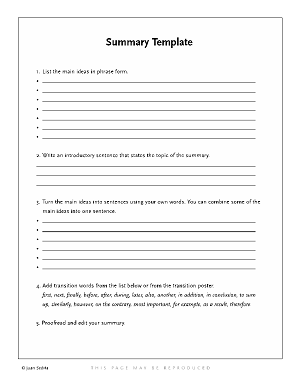Scaffolds to Support Summarizing

Summarizing is one of the most effective activities for improving both comprehension and writing skills (National Reading Panel, 2000; Graham & Perin, 2007). Summarizing enhances comprehension as students select, condense, and synthesize in their own words the big ideas of what they have learned. Summarizing also lets teachers monitor student comprehension. It’s not surprising that the Common Core has devoted one of the ten reading standards to summarizing:
Reading Anchor Standard #2: Determine the central ideas or themes of a text and analyze their development; summarize the key supporting ideas and details.
However, summarizing is a difficult skill to teach and use. In order to summarize, students must be able to understand what they are reading, separate the main ideas from the details, and reduce a large quantity of information to the most important main ideas.
There are several scaffolds that can be provided to students who struggle to write summaries. The first is to provide students a “how to” list for generating a summary that breaks the task down into a series of steps, such as the example below.
How to Write a Summary
- Read the material and identify the main ideas. Distinguish the main ideas from the details.
- Write the main ideas in phrase form.
- Begin the summary with an introductory statement that lets the reader know the topic you are summarizing.
- Turn the main ideas into sentences, occasionally including details when necessary to convey the main idea.
- Combine the sentences into one or more paragraphs.
- Use transition words to connect the sentences and the paragraphs.
- Proofread the summary for punctuation, spelling, sentence structure, and content.

Teachers can also provide a summarizing template, such as the one used in The Key Comprehension Routine shown here. A copy of this template can be downloaded from the Free Resources section of the Keys to Literacy website.
Here are some additional resources related to teaching summarizing:
- Summarizing (Reading Rockets)
- Teaching Students to Summarize (ASCD)
- The Art and Science of Teaching Summarizing to Comprehend (Educational Leadership)
Leave a Reply
13 Comments
Trackbacks/Pingbacks
- How to Summarize Text: A Gamer's Guide - […] memory aids. Just as a map helps you remember the layout of a game world, a well-structured graphic organizer…

 Joan Sedita is the founder of Keys to Literacy and author of the Keys to Literacy professional development programs. She is an experienced educator, nationally recognized speaker and teacher trainer. She has worked for over 35 years in the literacy education field and has presented to thousands of teachers and related professionals at schools, colleges, clinics, and professional conferences.
Joan Sedita is the founder of Keys to Literacy and author of the Keys to Literacy professional development programs. She is an experienced educator, nationally recognized speaker and teacher trainer. She has worked for over 35 years in the literacy education field and has presented to thousands of teachers and related professionals at schools, colleges, clinics, and professional conferences.
Summarizing a text that is read by my students is often a difficult task for them. It is also a difficult concept to teach, particularly students with reading comprehension difficulties. The summary template that you have included in your blog is something I would like to try with my students as it will help them organize their thoughts. I particularly love the idea of students first writing short phrases to identify the main points of the text and then asking them to turn those phrases into sentences. Thank you for this post.
Summarizing teaches students how to discern the most important ideas in a text, how to ignore irrelevant information, and how to integrate the central ideas in a meaningful way. Teaching students to summarize improves their memory for what is read.
I like the summary template
This was a very informative way of teaching kids how to Summarize. I enjoyed the video of the Sponge Metaphor. I feel the Summary Template will be very helpful as well.
The sponge Metaphor video demonstrated a great way to teach students how to summarize!
Much of the academic writing that students are asked to do, from the simplest reading comprehension questions that appear at the end of chapters in practically every textbook to formal research papers, involves summarizing. Reflecting on my own early educational experiences, I can’t recall ever being explicitly taught this, or, for that matter most other, essential writing skills. I realize that my own experiences have impacted how I teach writing; the opportunity to acquire a few more tools for the toolbox is a welcome one.
This was very helpful. I always have trouble helping students summarize their writing. Lots of good tools.
I would use this if I did any classroom instruction.
Summarizing teaches students to remember what they have just learned.
I have used a template in the past and, with practice, it really is a helpful tool for the students.
Great ideas
Very important to summarize for understanding
Summarizing is difficult, but the way you broke it down is excellent.